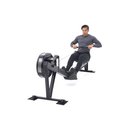From the opening minutes of "300," it was clear that director Zach Snyder's 2006 film set a new standard for physiques on the screen. Plenty of other movies had featured ripped leads, villains, or characters. But in "300," every single Spartan, dozens in all, perfectly blended the cuts of a comic-book superhero with the classical lines of Jacques-Louis David's "Leonidas at Thermopylae" —all while looking dirtier, tougher, and more defined than either.
These bodies, it turned out, were the result of a perfect storm of training and nutrition factors, all orchestrated by trainer Mark Twight and the staff from his Salt Lake City-based gym, Gym Jones. A former world-class alpinist, Twight applied all the intense physicality and strategic planning of his previous career to the challenge of making men look like mountains. He gave his subjects no quarter; they trained together shirtless in a single hall in Montreal, ate customized meals, and were subjected to regular unflinching critiques. Star Gerard Butler later said it was the first time anyone had called him "fat."
The film and its grueling workout regimen became the stuff of legend. But rather than embracing the role of the next Hollywood trainer, Twight turned his focus back to Gym Jones for most of the next decade, before returning to the limelight as Henry Cavill's trainer in 2013's "Man of Steel." After transforming Cavill into the most impressive Superman to take the screen, Twight reprised his training role for the long-simmering sequel of "300," titled "300: Rise of an Empire," which comes out today.
Since (spoiler alert) the Spartans all died in "300," the sequel demanded more than just uncovering the same old muscles. Twight dealt with mostly new actors, a new location, and a host of challenges that the original film didn't face. But the results ended up looking pretty familiar. A few days before the film's release, he spoke with Bodybuilding.com about the new film and shared some of the workouts that he used to design a new generation of warriors.
Q. How did "300" and the precedent it set loom over what you were doing?
No one, when the original came out, had any idea of the kind of impact it would have outside of the movie world—in particular in the fitness world. And I think that raised the bar really high for expectations for the second one.
But then, the storyline of the second one goes in a different direction, where the main characters are an alliance of free Greeks whose profession isn't war, but rather, they're basically citizen soldiers. So on one hand, you wouldn't expect them to look like the Spartans, who grew up on training and fighting in the first one, and were united all the way to that big battle in their intent and spirit. This, however, is a shaky political alliance to fight off a common enemy.
But then, from our perspective, it's not like we're going to say, "Well, we'll give them a few percentage points of body fat because they're not professional soldiers" or anything like that. We were going to go as hard as we could and see how it all played out.
How had you grown and changed as a trainer since the original film?
Most of the training for the original happened in late 2005, and we wrapped in January of 2006. The second one was all shot between basically April and October of 2012. So let's call it seven years, and yeah, I learned quite a bit. But mostly it comes down to being more adept at addressing a greater variety of problems.
During the first film—and on this one—when you have so many people, there's no way really to individualize the work. You could try and put certain groups together who have similar characteristics and abilities and push them within those smaller groups, but overall, I think with cast and stunt crew included, on the first one we were managing about 35 people total, and on this one, about 40. And so it comes down to the central piece of our training philosophy, which is: "Find the problem, fix the problem." And I think I didn't necessarily have as accurate an understanding of what that meant on the first one as I do now.
The sequel also posed a number of different problems that "300" didn't. On the original, we had pretty much total control of all the people. We had them united in one single place of training, one location, and we had a kitchen in the training hall with three chefs on-site. All the meals were prepared according to our menu and the timing that we designed. We could fine-tune the diet for people: more calories, less calories, more protein, less protein, higher fat content for one guy, but another guy needs more carbohydrates because his energy is always low.
But with "300: The Rise of an Empire," the movie was shot and most of the preparation was done in Sofia, Bulgaria. I don't want to overstate it, but it wasn't the same as having all the resources we had in Montreal or Los Angeles on the first "300." And then we had a number of cast who were obligated to other jobs; they had to do their training in other locations prior to coming to Sofia. So we had a lot of moving parts and not everybody in the same place at the same time, so we couldn't achieve that small unit integrity that we had on the first one, where everyone went through the same hardship all together.
We obviously had some language issues as well, because there were a number of stunt guys from the United States, a couple from England, but we also had guys from Bulgaria, from the Ukraine, from Poland, from Germany, all of whom had English as a second language—if they had English at all. So the educational process that we could go through training on an individual basis, say, for "Man of Steel," we couldn't do here in the same way.
I recall trainers from other films, such as "The Hobbit," telling me that they utilized heavy everyday stuff from the set for training. You, on the other hand, shipped a miniature version of Gym Jones all the way to Bulgaria. How was that received?
It was interesting. One of the reasons we had it shipped was because we had no idea what would be available to us there. And there was no way I was going to try to show up and cobble something together, because I believe you need to walk into a gym and know immediately that it's a place of work—it's separate, and it's something different from outside.
One of the things we've learned over the years is that the training environment is absolutely essential to the outcome. And I think when you're just finding stuff to do, there's no way you can shift someone's psychology from the instant they walk in the door. And so we put everything together and weighed it, and then we realized we could actually find the rubber flooring we use in the Czech Republic, so we didn't ship that over. But it was still a little over 5,000 pounds that was air freighted over to Bulgaria.
So they would walk in the gym and say, "Wow ... kettlebells. We've seen those before." And there were barbells and bumper plates and dumbbells and everything, so we really had a small version of the gym. Still, it took a number of weeks for guys to adapt to it, because the weight training thesis in Bulgaria is a little different than what we do. Obviously Olympic lifting is a big national sport, and the other big sports are wrestling, and maybe judo. So Olympic lifting and bodybuilding are really the main focus of the way those guys train, and when we started laying some stuff on them, they were having their lungs turned inside out and thinking, "Wow, there's no way this could possibly work. I like doing this other thing, and I don't like this, because I'm no good at it."
But on the other hand, we had some really good examples of what we do, one of them being Clay Enos, who is the unit photographer for all of [Zach Snyder's] films. He started training with us and according to our philosophy in late 2006, so at that point, it had been for five or six years. One day, we were working with the stunt guys, and we said, "Let's work up to a heavy deadlift today." And so at 170 pounds, Clay pulled 435. There was only one of the stunt guys who pulled more, and that guy came from a weightlifting background, and he also weighed 225 or something.
So these guys started to realize, "Wow, this guy is following the things that these guys do and teach, and he can do this stuff. Maybe we should kind of pay attention." And so we would work with [the local guys] three days per week doing our thing, the power endurance and strength endurance-style training, and the other two days each week, we left them on their own to do what they were used to: the heavy lifting and bodybuilding-style training.
300: The Rise of an Empire Large Group Workout
Because of the number of guys we were training at any one time, we ended up doing a lot of things that were in the vein of say, max reps in 60 seconds, or X reps every 30 seconds for 10 minutes, and then fine-tuning the number of reps and the weights. So in the first minute, guys might be doing 15 seconds of work and getting 15 seconds of rest, and by the end, it's taking longer, so they're getting less rest.

BodyFit
$6.99/month- 2,500+ expert-created single workouts
- 3,500+ how-to exercise videos
- Detailed workout instruction
- Step-by-step workout tips
- Training at gym or at home
- Access to Workout Plans
- Access to Bodyfit App
- Store Discounts
Already have a Bodybuilding.com account with BodyFit? Sign In

What comes with BodyFit?

- Instructional Videos
Don't risk doing a workout improperly! Avoid injury and keep your form in check with in-depth instructional videos.

- How-to Images
View our enormous library of workout photos and see exactly how each exercise should be done before you give it a shot.

- Step-by-Step Instructions
Quickly read through our step-by-step directions to ensure you're doing each workout correctly the first time, every time.
Our thesis for this movie, and for the original "300," was to expose existing muscle, unlike "Man of Steel," where Henry [Cavill] had to build new muscle and a fair amount of it. We couldn't do that with so many guys, because we didn't control the nutrition as carefully, and again, it's a total of 40 guys.
We knew, however, that when guys are really, really lean, they look huge on camera. And so that was the direction we went. It's not a bodybuilding bulking phase. It would be more like a leaning phase, but a lot of it is high-intensity, power endurance, and interval training with one heavy-duty strength session per week.
We've done jobs where we had everything in our favor: We had our gym, we had really good meal providers to work with, and we had the right sort of recovery available, like massage or acupuncture. But on this job we were kind of on the front lines, without everything that we would want to have available, and we were still effective.
So when you think about all the "secrets" that people have for this style of training, like this certain machine or this certain supplement, I found myself just realizing, "Wow. When you just keep applying the pressure and educate people, then you can produce a really good result." Maybe we could do better if we had more precise control, but it's remarkable how much we can accomplish by tinkering with the psychological aspect and really hammering people with the training.
You've written that the original "300" actors trained shirtless so "everyone knew what everyone else had and how they were progressing." Did you do that again?
We didn't, although a bunch of days it was hot enough that people took their shirts off. You know, on the first film we were a little more hardcore, partially because we were setting up something new, in a way.
Zach is a very physical guy, and he really changed the way that a lot of these movies are shot, or what he expects from the actors. And so his thesis on the original "300" from the beginning was, "Make these guys as physical as possible," and he made receiving the roles contingent on doing the training, because the more physical you make the actor, the less he needs to be doubled, and therefore the more believable it is. The audience isn't stupid. You can tell when it's someone else. Even if you don't ping to it consciously, you know, "OK, that can't be that guy."
And then he was in there leading from the front and training with us for the eight-week prep period. He was in the gym every morning before everyone else. And that went a really long way to informing the aesthetic and how we handled everything. I think we were a little more hardcore because of it. We were just like "alright, everybody strip." On Monday morning, everybody would come in, and it was pretty clear what they did on the weekend. They could hide it with a T-shirt, but not now. We could see.
On this one, we didn't have the same vibe. However, one thing that did happen that I don't think a lot of people noticed necessarily was that we had a "lunch group" made up of Noam Murro, the director, and a group of guys who work behind the camera. Every day when we broke for lunch, those guys rushed down to the gym and got a 45-minute workout in before going back. At that time, Noam would just go from the director, who was telling people what to do, to coming into the gym with total surrender and saying, "Tell me what to do."
One of the fascinating things we see all the time with training was that at a certain point he said, "When I come in and I train, I'm more effective in the afternoon. I usually just don't have this much energy in the afternoon and I get frustrated. I come here, you totally kick the shit out of me, and I go back to the set, and I actually have the energy and the clarity to make my afternoons more effective."
So they didn't have the same influence on the stunt guys and the cast, except when they'd be in the gym and we'd have certain common workouts, if some of the guys who were actors saw how hard the guys behind the camera were working, they'd step it up a notch as well.
300: Rise of an Empire Burner Workout
This was a workout where we could have two groups of three working simultaneously. We had three Concept 2 rowing machines and three barbells, and plenty of kettlebells. We must have been feeling ornery this day, because the sessions notes were, "Put the 'Fuck You' Into 'Fuck You Friday.'"
The point here is to truly do max reps, so go to failure. There is a huge difference between "can't" and "won't." Most people give up. If you do 40-50 goblet squats, full ROM, with the 24kg kettlebell and respect the rest interval, then all will become very clear. Don't save anything for later; floor it and try to hang on.
300: Rise of an Empire Burner Workout

BodyFit
$6.99/month- 2,500+ expert-created single workouts
- 3,500+ how-to exercise videos
- Detailed workout instruction
- Step-by-step workout tips
- Training at gym or at home
- Access to Workout Plans
- Access to Bodyfit App
- Store Discounts
Already have a Bodybuilding.com account with BodyFit? Sign In

What comes with BodyFit?

- Instructional Videos
Don't risk doing a workout improperly! Avoid injury and keep your form in check with in-depth instructional videos.

- How-to Images
View our enormous library of workout photos and see exactly how each exercise should be done before you give it a shot.

- Step-by-Step Instructions
Quickly read through our step-by-step directions to ensure you're doing each workout correctly the first time, every time.
One thing I've learned about you is that you're never just training bodies; you're always cultivating a certain mindset. Were you able to win everybody to your vision of what you've called "the art of suffering?"
Not everybody. When you're training guys in the U.S. there are certain types of pop culture references or jokes you can throw down, and people will get it. But Sullivan [Stapleton], Callan Mulvey, David Wenham—they're Australian. That's a completely different attitude. Then we had Bulgarian and Ukrainian guys we couldn't even speak to. Maybe were able to show them a different way, but in a psychological sense, I don't think we were able to reach those guys.
There were a few standout people though, and Eva Green was one of them. She comes from a pretty non-physical background. She played some tennis, and she runs every now and then, but that's the extent of it. And here she is, thrust into this super-heroine type of role, where she's got to fight with one sword, two swords, assassinate some guys with daggers and a scarf, draw a bow, and sell the fact that she can do it. And so in Paris, I had her double, and another stunt guy, Rich Cetrone, who was on the original "300," who comes from a boxing and martial arts background and is a total stud. So Eva was with me for about an hour and a half per day, and with them for about an hour and a half per day.
"She comes from a pretty non-physical background, and here she is, thrust into this super-heroine type of role, where she's got to fight with swords, assassinate some guys with daggers and a scarf, draw a bow, and sell the fact that she can do it."300: Rise of an Empire Eva Green Workout
Eva wasn't a girl you could throw in the deep end and say, "Swim or drown," as we often do with some of the male trainees. We started easier and progressed slowly. This is one of the sessions Eva worked up to:
300: Rise of an Empire Eva Green Workout

BodyFit
$6.99/month- 2,500+ expert-created single workouts
- 3,500+ how-to exercise videos
- Detailed workout instruction
- Step-by-step workout tips
- Training at gym or at home
- Access to Workout Plans
- Access to Bodyfit App
- Store Discounts
Already have a Bodybuilding.com account with BodyFit? Sign In

What comes with BodyFit?

- Instructional Videos
Don't risk doing a workout improperly! Avoid injury and keep your form in check with in-depth instructional videos.

- How-to Images
View our enormous library of workout photos and see exactly how each exercise should be done before you give it a shot.

- Step-by-Step Instructions
Quickly read through our step-by-step directions to ensure you're doing each workout correctly the first time, every time.
For initial couple of weeks of fight training, she could never get that aggression and treated it more like dance choreography, because she didn't have that sort of aggression that we learn in the context of certain sports in her background. It was a fascinating process to watch her find it. [Gym Jones trainer] Michael Blevins saw the movie the other day and said, "I never would have guessed that she didn't have physicality in the previous 20 years of her life."
"300" thrust Gym Jones and your style of training into mainstream prominence. How has your overarching vision for the gym and its mission changed or grown since then?
When the original "300" came out, we had a website, but we had no plan. I was against selling stuff at that point. And within the first month, we had almost 13 million hits on the website and it crashed our server.
But that really speaks to Zach's vision for that movie and how different it was. People were like "What the fuck? How did this happen? How did all these guys end up looking this way? How do we find out more about this?" And we had nothing to say except, "Um, we fed them food and had them work really hard."
In the beginning, I wanted to preach to a small choir, and to practice our philosophical message. And I think what's developed over the years from communicating through our website, and from teaching seminars, from interacting with all kinds of people, is that we've become more effective at communicating.
The point of doing these movie jobs, really, is just to say, "Look, this is what can happen." You can make all the excuses you want, like "Oh, that guy gets paid to train," or "That guy doesn't have a family" or "That guy doesn't have another job," but do what Andrew Pleavin did—just do 20 percent of what he did—and you're going to have a pretty powerful result. You decide what's important, which is what he did, and you'll make time for it.
With Twight's help, Actor Andrew Pleavin lost 30 pounds in 5 weeks to reprise his role as Daxos.
I hope what we can do with the training plans and the philosophical treatises on the site is to give people support, but not to make them dependent. It's to make them independent. To educate people, to inspire people—that's the path I want to go down. Because once they educate themselves and put it into practice, they realize, "Wow, I'm able to control things I didn't think I could control about my body, my health, and my life."
One guy shares that with two, two share it with four, and then suddenly, as a society, that's a pretty big step. We're in a better place.






